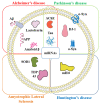The Evolving Landscape of Exosomes in Neurodegenerative Diseases: Exosomes Characteristics and a Promising Role in Early Diagnosis
- PMID: 33406804
- PMCID: PMC7795439
- DOI: 10.3390/ijms22010440
The Evolving Landscape of Exosomes in Neurodegenerative Diseases: Exosomes Characteristics and a Promising Role in Early Diagnosis
Abstract
Neurodegenerative diseases (ND) remains to be one of the biggest burdens on healthcare systems and serves as a leading cause of disability and death. Alzheimer's disease (AD) is among the most common of such disorders, followed by Parkinson's disease (PD). The basic molecular details of disease initiation and pathology are still under research. Only recently, the role of exosomes has been linked to the initiation and progression of these neurodegenerative diseases. Exosomes are small bilipid layer enclosed extracellular vesicles, which were once considered as a cellular waste and functionless. These nano-vesicles of 30-150 nm in diameter carry specific proteins, lipids, functional mRNAs, and high amounts of non-coding RNAs (miRNAs, lncRNAs, and circRNAs). As the exosomes content is known to vary as per their originating and recipient cells, these vesicles can be utilized as a diagnostic biomarker for early disease detection. Here we review exosomes, their biogenesis, composition, and role in neurodegenerative diseases. We have also provided details for their characterization through an array of available techniques. Their updated role in neurodegenerative disease pathology is also discussed. Finally, we have shed light on a novel field of salivary exosomes as a potential candidate for early diagnosis in neurodegenerative diseases and compared the biomarkers of salivary exosomes with other blood/cerebrospinal fluid (CSF) based exosomes within these neurological ailments.
Keywords: Alzheimer’s disease; Parkinson’s disease; biomarkers; neurodegenerative diseases; salivary exosomes.
Conflict of interest statement
The authors declare no conflict of interest.
Figures





References
-
- Obrocki P., Khatun A., Ness D., Senkevich K., Hanrieder J., Capraro F., Mattsson N., Andreasson U., Portelius E., Ashton N.J., et al. Perspectives in fluid biomarkers in neurodegeneration from the 2019 biomarkers in neurodegenerative diseases course—a joint PhD student course at University College London and University of Gothenburg. Alzheimer’s Res. Ther. 2020;12:20. doi: 10.1186/s13195-020-00586-6. - DOI - PMC - PubMed
Publication types
MeSH terms
Substances
LinkOut - more resources
Full Text Sources
Other Literature Sources
Medical
Research Materials

